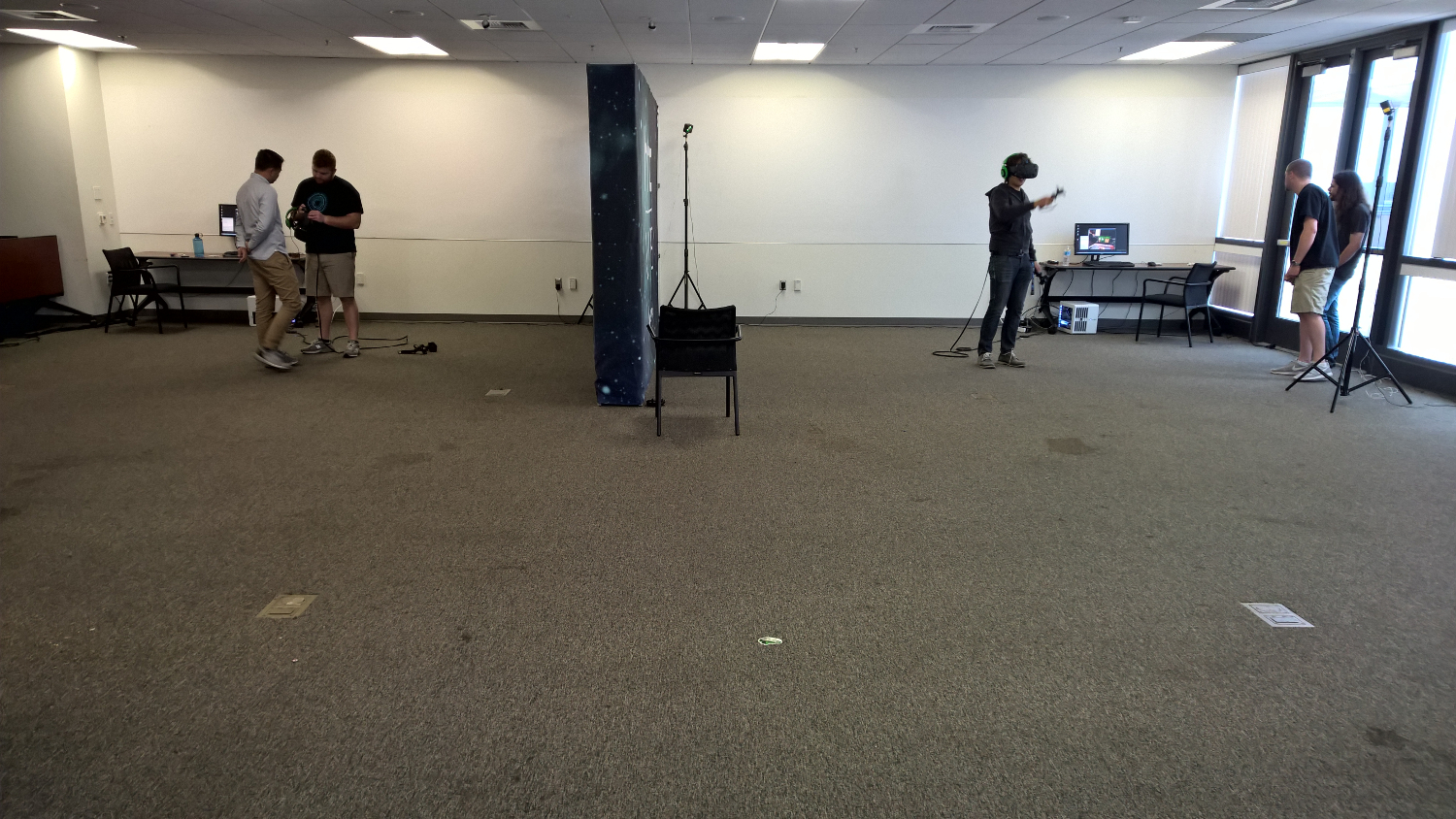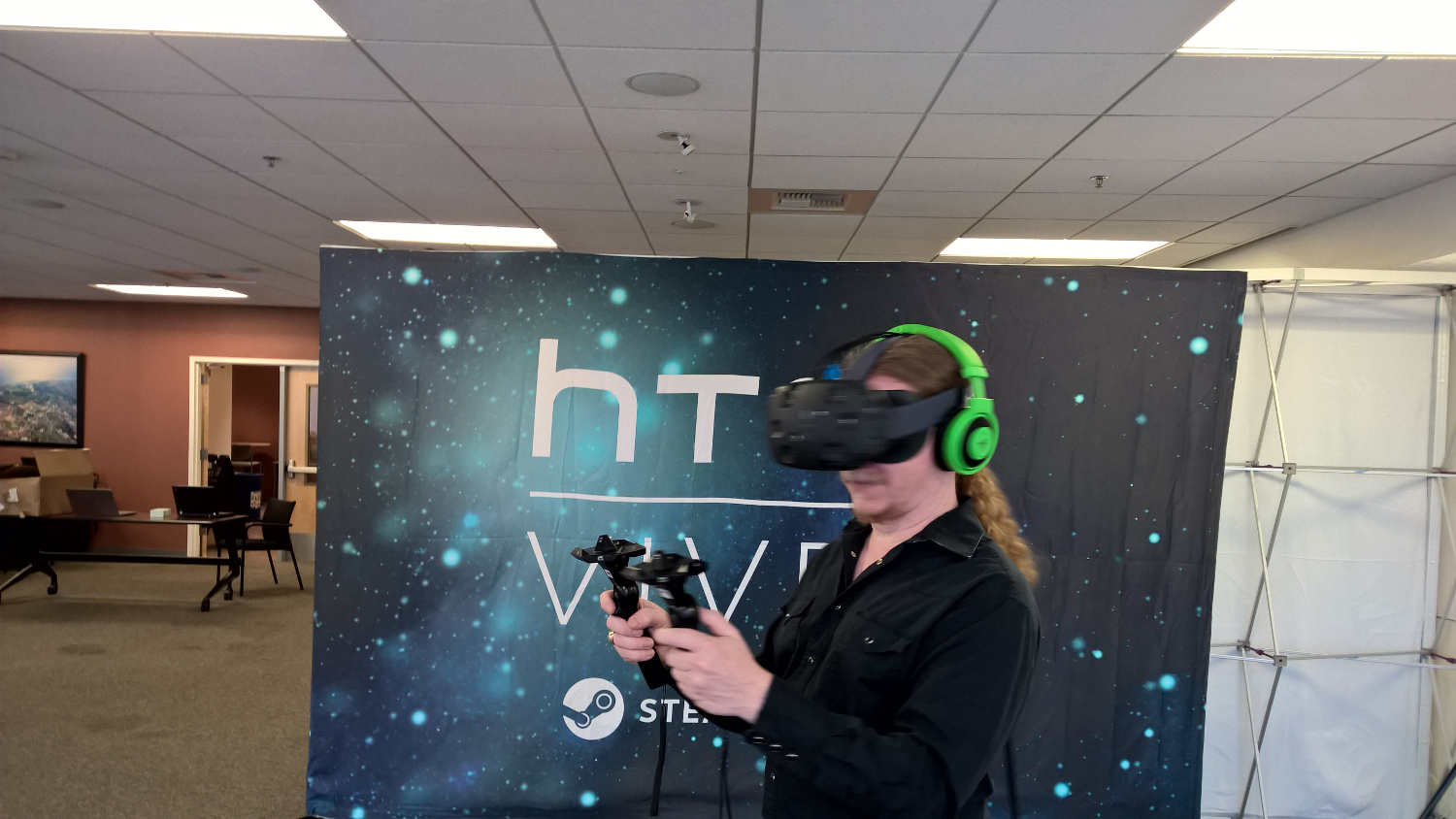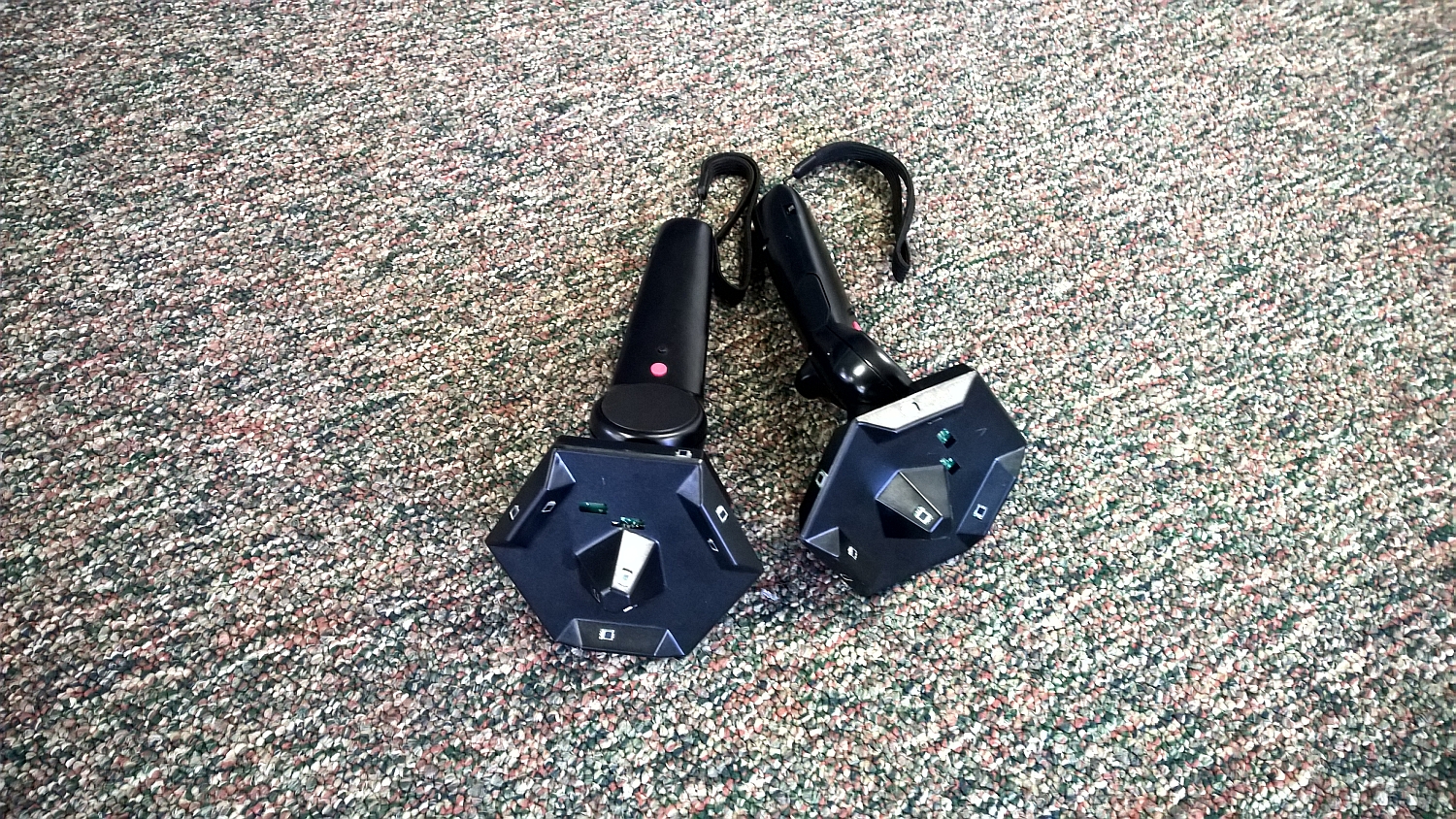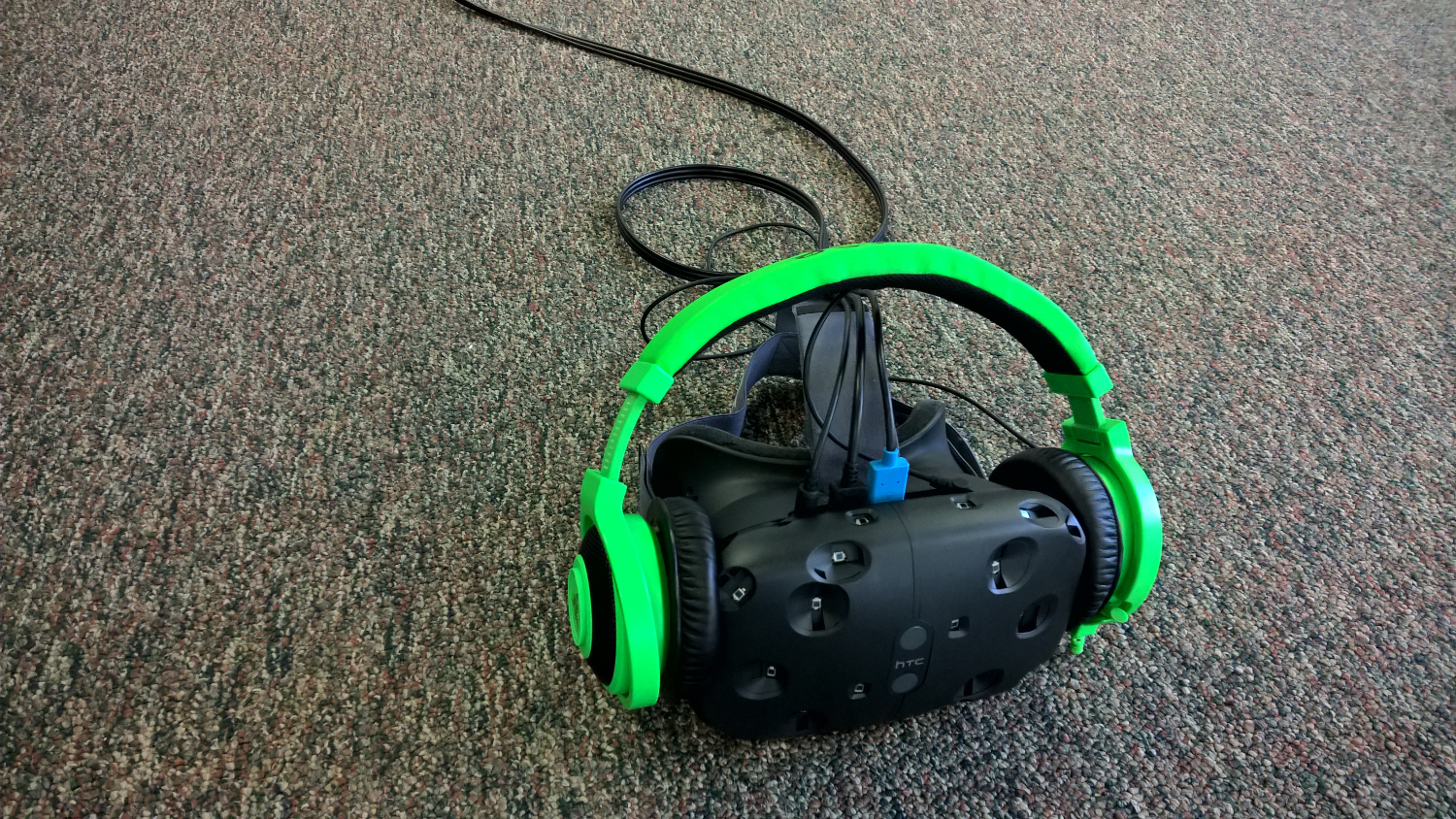A Life-Changing Experience
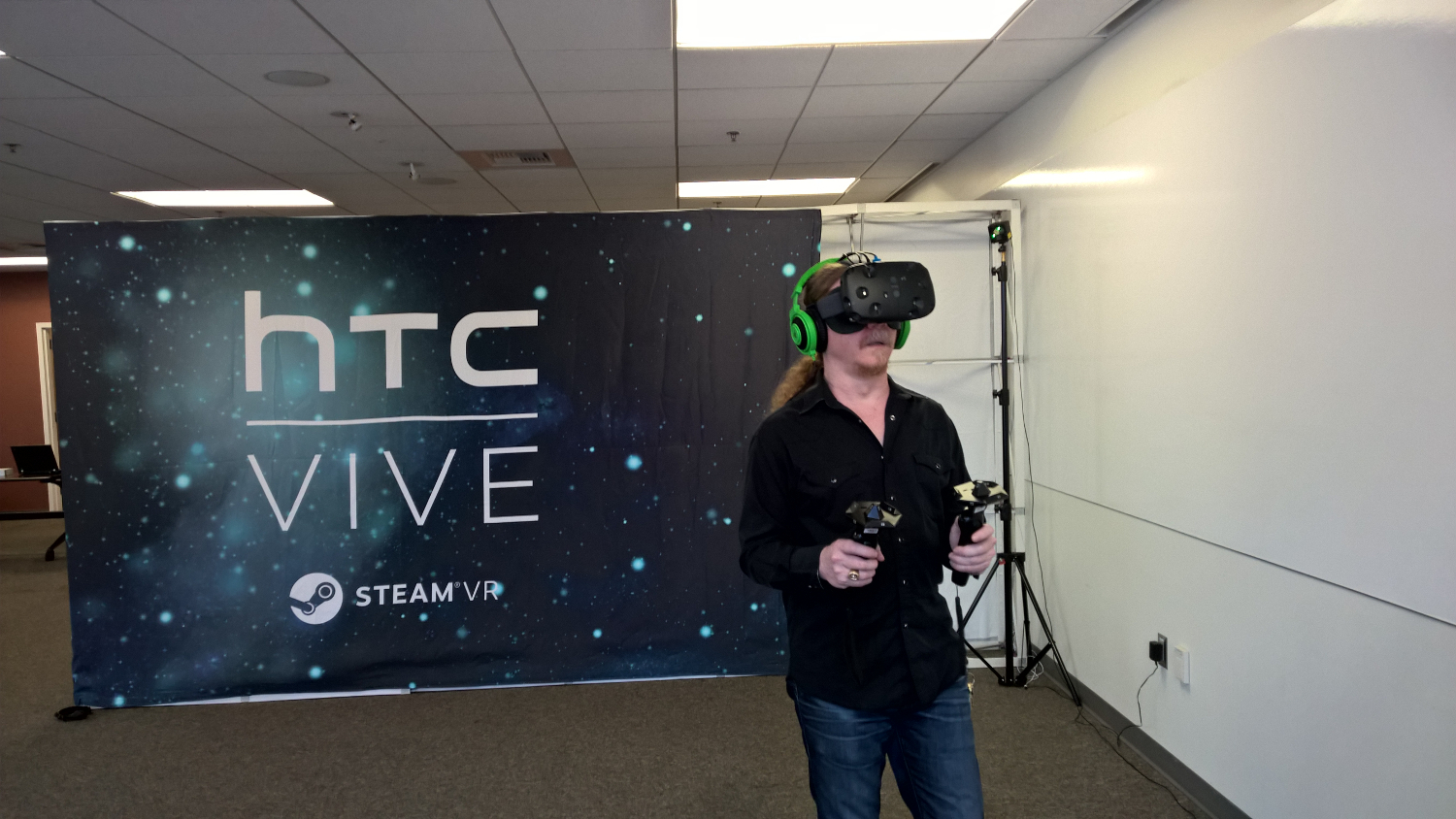
That’s me up there, mouth agape, experiencing the most incredible thing I’ve ever experienced: the HTC Vive VR headset.
I have been hearing about VR for some time now. And I don’t mean all those admirable yet misguided attempts in the 80s and 90s – remember VRML or the woefully under-appreciated Virtual Boy? No, those were far before technology was ready to handle the capabilities, potential and technical requirements of VR, and it clearly showed. But over the last few years, I have heard people who have exclaimed that current virtual reality experiences have to be seen to be believed, and that they are even better than real life.
Come on, now. Let’s all just relax.
At least that’s how I used to respond. However, after experiencing the HTC Vive at a demonstration offered at the University of California, Irvine, I can safely say it has finally arrived. And those people were right, my mouth-agape expression in the header image says it all: the experience was life-changing.
I know that sounds like hyperbole, but I assure you it’s not. I expected something good, but this was so far beyond my expectations that I’m uncertain as to how I’ll be able to put the experience into words.
I should also mention this post uses the word ‘virtual’ a lot. It’s very strange having to write this post, and constantly specify whether I’m talking about the real world or the virtual one; it’s something I’ve never had to do before, but hopefully will have the opportunity to do many times in the future.
Firstly, as you can see in the image below, not much is required to do absolutely incredible, amazing things to your sense of reality. A big empty room, a likely powerful PC the specs of which were not revealed, two room sensors (which were very small), headphones and the headset. That’s it, and you can go anywhere you would like.
I was asked to put the headset on, and the dual 1080p, 90hz monitors teleported me to a room that looked not unlike an unused holodeck, only all in white and of infinite area, and I was surrounded by a ring of floating panels that looked like posters for experiences you could have, as well as a sign indicating Aperture Science is involved, which other than certain death can only be a good thing.
The final step was to put on the headphones and be handed the controllers that you can see in the header image and the images below:
(Disclaimer: I was not allowed to get any pictures of the demos themselves)
As the demonstrator was handing the controllers to me, I could see their virtual representations floating in space right in front of me. Once I had them in my hand, I was told to slide my thumb around a round capacitive touchpad on the front of the controller. Doing so caused the virtual flat pad to become a color wheel, in which I could select a color by pressing down, then pulling the trigger which would cause a balloon of said color to inflate from the top of the controller. I could then bat the balloon around with the controller from whence it came.
You wouldn’t think batting a virtual balloon around in a big empty virtual space would be all that entertaining. I assure you it was. I batted one forward, batted one backwards, batted one with both virtual controllers, batted one back and forth between the virtual controllers, and watched in amazement as they eventually floated up into infinity. I could have done that for hours and never gotten bored. At last I know how the cat feels when she gets hold of a ping-pong ball.
Great as that was, it was nothing compared to what came next.
I was told I would be on the deck of a sunken ship, far below the surface of the ocean. Sure enough, the holodeck faded and there I was, on the deck of a sunken ship with fish swimming right up next to me. It was unlike anything I have ever experienced. There was minimal interaction other than poking at virtual fish, but the immersion and sense of place were absolutely unparalleled. It was a sense of wonder I haven’t experienced since I was a child, if even then. But that wasn’t all – I hear a noise behind me, and when I turned I saw a massive blue whale swim into view, then curve around to the front of the boat where I was standing, my face to it’s huge eye. After hanging around for a moment, it swam off into the blue depths. It may not sound like much, but it was absolutely incredible, an immersive, encapsulating experience like I’ve never seen.
It looked something like this (credit: vrscout.com)
Next was a cooking demonstration that was fun, but not as awe-inspiring as the rest. Here, you filled the role of a chef in a futuristic diner’s kitchen, and you had to pick up foodstuffs and put them in a pot to make soup. The items didn’t fall into the pot naturally, and were difficult to pick up, but once I got the hang of it I was making soup like no one’s business.
The third demo was a paint program, and in some ways it was the most impressive of all. Developed by Google, it allowed you to paint using light in neon hues, but you could draw in the air. Controls worked in such a way that using the same touchpad that selected colors for the balloon demo would in this case rotate a virtual cube, each side of which would allow you to select brushes, styles, effects, and colors. You could then draw in the air, and walk around and through your creation. Not only that, with brush types like ‘fire’ and ‘plasma,’ what should be a relatively mundane experience became a mesmerizing artistic endeavor. I could see myself spending hours just doodling in virtual space, especially with the impressively intuitive controls.
Lastly, I knew they wouldn’t let me get away without visiting Aperture Science. In a scene reminiscent of the opening moments of Portal 2, I found myself in a small industrial room on the other side of an administrative office with a robotic voice asking me to open the “correct” drawer, and mocking me because I kept opening the wrong one (one had the cake, I knew they wouldn’t lie to me). I was then asked to open the bay door, which caused a scarily life-sized malfunctioning robot on the other side to lurch towards me. I actually backed up as it came towards me. I then had to disassemble it and attempt a repair that was doomed to fail. The room collapsed, and the massive Aperture industrial complex was seen in the background giving a sense of scale I’ve never before experienced first hand, and that included an intimidating appearance by the massive GlaDOS. It’s good to see her doing so well, and that she’s not a potato.
And with that, the demo ended, and I was left feeling like a kid who just discovered Santa Claus is real, and actually does fly around the world squeezing up and down chimneys in one night. There are some unknowns, however. For example, looking down I didn’t see any feet, I could feel the cables tethering me to the PC against my back, and I even stepped on them a few times. There’s not a significant amount of mobility, just limited to the virtual room, so how will new experiences tailor themselves these constraints? These are minor quibbles for ow, but ones that will need to be addressed as the technology improves and people long for more and more interactive, expansive experiences.
One other thing: Unlike other VR headsets that are being developed, this one uses laser scanners that you can see in the image below.
One was placed in one corner of the room, and the second in the other corner, and they have two spinning wheels as you can see. One spins horizontally and one spins vertically, creating an invisible laser grid throughout the room. These are read by sensors on the headset and controllers, which allow you to move around in the virtual space, however if you approach a *real* wall, a virtual wall of green lines will appear in your virtual space so you can avoid an embarrassing yet amusing impact. I am under the impression that will switch to IR in later versions although I have no confirmation of that. I was also told that if you set them opposite each other in a round room, they will still demarcate a square space and virtual room, although again, I can’t confirm.
Which brings me to what excites me the most about all of this. Even though VR is still in its infancy, it is still providing experiences to which there is simply no comparison. If that’s what it’s doing *now,* if these demos are only the beginning, think about what it could bring in the future. Not just standing on the bow of that ship, but swimming away, and exploring the whole ocean, complete with all it’s fun inhabitants, scary places, and beautiful places too. And you could do it from the safety of your own room, and your own headset, without worrying about pesky issues like being eaten alive or crushed like a bug under the weight of the entire ocean.
Or you could just virtually be here. That’s nice too.
That’s why although I was excited before, I’m now giddy with anticipation. I predict that this will be a sea change in computing and gaming, and I am equally as excited to see it used in other ways, such as, but my no means limited to, allowing us to visit places we couldn’t otherwise go – imagine using the Vive to travel back to ancient Egypt and visit the pyramids right after they were built, complete with colorful hieroglyphics and the population of the time. Or ancient Greece. Or Rome. Or Babylon, or Mesopotamia, or anywhere else, any time else.
There’s even a powerfully bittersweet story about a dying grandmother using VR to experience the outside one final time. How wonderful is that?
So, I’m sold, and how. It could be used in education, medicine, the treatment of phobias, you could explore the inside of the human body or the outer reaches of space, ride a roller coaster or virtually visit Disneyland; the potential boggles the mind. I’m not just excited for this nascent technology, but for where it will go from here, the astounding things we have yet to see.

